What to Wear in Westeros: Dressing and Undressing in the Seven Kingdoms
by Nadia Connor
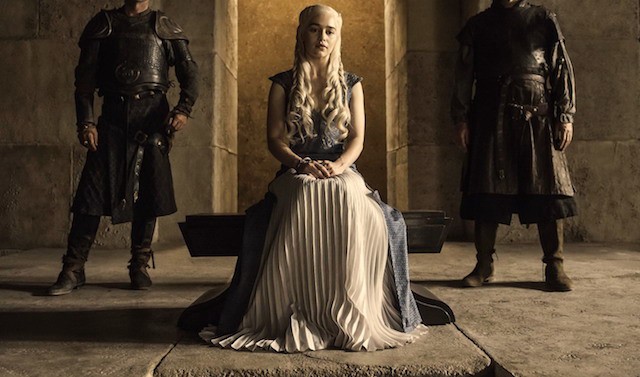
The women of Westeros do a lot of self-fashioning through fashion. As in all regimes which deny civic and personal agency to women, costumery and textiles offer an indirect expressive register unavailable elsewhere, a textural iconography of self. But they are also boundaries, limits: ways in which a world controls and curtails female bodies and identities. We viewers learn a lot about the women represented on the show — about their hopes, desires, ambitions, deceptions, interior worlds — through the clothes that they choose (and a lot about their position in that world through the clothes they can choose). We’ve seen Queen Cersei don a gold corset-breastplate over her signature red dress as she awaits the invasion of King’s Landing, a sartorial expression of her desire to be standing on the battlements herself with a longsword. We’ve seen Sansa ditch her simple, homely half-pony for the elaborate hairstyles of the south in misguided emulation of the Queen Regent, a restrictive styling she has only recently been free of after fleeing King’s Landing. We’ve seen Margaery signal both her sexual liberalism and her sexual manipulation through plunging necklines and exposed midriff.

But individual expression isn’t the only thing that’s expressed sartorially. As Sarah Mesle notes at the LARB, in Game of Thrones, apparel is political, too: far from being irrelevant frippery, “it is the show’s politics, manifest in a different register.” And self-expression, personal agency and bodily autonomy (who has them, and to whom they are denied) are integral to the politics of Game of Thrones, just as they are integral to the politics of our (real) world.
Cersei’s breastplate signals a personal desire through its armorial styling, her wish to be active in the world, smashing it on the battlefield with her brothers instead of cooped up indoors waiting for fate to find her; it also signals the limitations of her purview through its sheer ornamentality: it is imitative of a soldier’s garb, not the real thing. Instead of forming an actual protective plate, the sort of thing which enables its wearer to compete in the active world and physically enforce their will, it forms part of Cersei’s corset, binding her body and bizarrely tracing the shape of her breasts in embossed metal, emphasizing the way in which Cersei’s political world commands anatomical fact, casts it irrevocably in metal, and uses it to limit the possibilities of women’s identities.
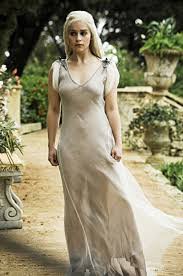
Daenerys Targaryen, too, exists on this dramatic nexus between political power and personal identity. Her rise has been swift and untrammeled, and she has acquired a vast range of political personae, with outfits to match. After making an effective break from sexual slavery early in the first series, she moved from cultural to martial imperialism by way of miraculous messianism, acquiring cult leader status as the only conviction politician on the show since Ned Stark. She is now struggling to implement autocratic anti-slavery laws in Mereen and Yunkai; and all in the name of pressing a hereditary claim on the tyrannical crown of Westeros. She has the longest list of titles of anyone on the show — an impressive feat in a show where everything is the “noun of another noun” — and a wardrobe which transforms with every new incarnation.
When we first came to know her, she wore a delicate pink gown, gossamer-light and flowing, translucent, so that her body was displayed to Khal Drogo as the light shone through it (and to us, her pay-cable viewers, to whom she was also being sold) powerless and the property of her brother. She was frequently naked, her body displayed for (our) consumption, with the blank, shell-shocked expression of the severely traumatized. As viewers, our gaze was aligned with Drogo’s, paying customers also indulging in the sexual-aesthetic spectacle of her nudity; but we were also invited to criticize it, to deplore her subjection to enslavement and sexual violence. It is a confusion the show has never managed to resolve.
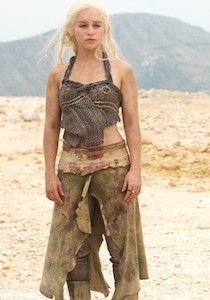
But Daenerys déshabillé has gained new meaning as the seasons have advanced. As her agency grows, her earlier, vulnerable nakedness gives way to a more ferocious nudity, and we watch her climb from her bath to stand queenly and uncowed in front of Daario as he pledges his service to her, or emerge unscorched and naked from a pyre having birthed three dragons. What began as a symbol of powerlessness transforms into a sign of autonomy and bodily control. The question of how our sexualized interest in her should have changed remains unanswered.
Dressed, too, she’s unbeatably queenly. Her clothing becomes an index of a different kind of cultural narrative, providing a problematic iconography of difference contrasting Daenerys with the Dothraki. Following her marriage, Daenerys swaps the gossamer slips for more practical wear: making like a Dothraki, she sports an animal skin crop-top and trousers (so she can ride astride, like all the coolest girls in Westeros) to lead her Khalasar to freedom from the desert. But it’s not only practicality and adaptability that’s being signalled here. Poised to start a cultural revolution from the inside, Daenerys gains trust amongst the Dothraki through reflective sartorial surface mimicry, for which she demands repayment in ideological terms. Daenerys may dress like Dothraki, but she still thinks (and, importantly, looks) like an imperialist Westerosi, ready to proliferate her Western values amongst the Orientalist hordes, her white hair and white skin signaling her (cultural, ethical, racial) difference.
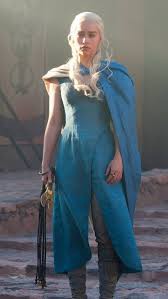
So it’s no surprise that, after Westernizing the Dothraki, Daenerys ditches their desert garb and gains a new wardrobe staple: cerulean blue, cap-sleeved, v-necked, with a front-split skirt for adaptability. Ever-practical, this dress can be teamed with trousers for riding and marching, or with a new pleated underskirt for ceremonial occasions. Daenerys is developing her regnal identity, at once pragmatic and stately, and her clothes to match. She is moving on from her conquest of the Dothraki; and as both ideological and martial leader, she now has no need to gain trust through shared points of cultural reference: she can enforce. And she has her eye on a bigger prize, with a different set of sartorial signals, new cultural cues; and consequently, she’s looking more and more like her Westerosi counterparts, across the Narrow Sea, whose crown she hopes to usurp.
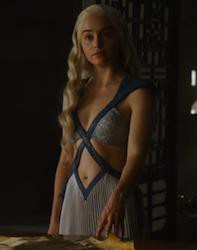
Which brings us to the weirdest addition to the Targaryen wardrobe this season. Following her night with Daario, she puts on one of the strangest get-ups we’ve seen on the show so far. Structured, yet revealing; disciplined, yet flowing; combining bondage-wrapped midriff with epaulettes and sweeping pleating, it is complex in signification, fusing regality and sensuality (and more than a little sci-fi styling). What to make of this new sartorial shift?
Daenerys is off the road, done fighting (sort of). She is working out what kind of peacetime ruler she is going to be. She is working out how to free slaves, dispense justice, heal the wounds of the past and create a viable community for the future. She is working out how to be woman who is both powerful and sexual. She is like no-one else in this world. And she has a dress to evoke this difficult transition: complicated, fantastical, theatrical, more than a little uncomfortable-looking. It also has the discomforting visual effect of carving her body into segments, delivering a sly reminder, even at a moment of triumph, of the ways in which, in Westeros, inconvenient bodies are dismembered, and female bodies are itemized and sold. Whether it’s a regnal robe or a snare is yet to be seen.
Previously: On the Women of Game of Thrones
Nadia Connor is a writer based in London.